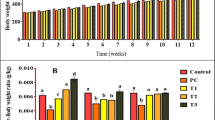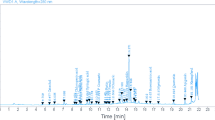Abstract
The aim of the study is to investigate the in vivo attenuation of alcohol- and cadmium chloride–induced testicular toxicity modulated by Silymarin in male Wistar rats. A total of fifty-six (56) Wistar rats were used for this study and they were randomized into seven (7) groups of eight (8) rats each. Group 1 was control rats; Groups 2–7 served as the experimental groups. After 6 weeks treatment duration, the rats were euthanized, semen was collected for semen analysis, blood samples for testosterone, and FSH and LH assay determination, and left testes was harvested for histological analysis. One-way ANOVA was used to compare means at p-level < 0.05 was considered significant. Findings from this study have shown that alcohol and cadmium chloride adversely affected semen parameters, testosterone, and FSH and LH hormone milieu. Data also showed that Silymarin administration attenuated the adverse effect of alcohol and cadmium chloride on semen quality and hormones associated with reproductive functions. Hence, Silymarin mopped the effect of in vivo attenuation of alcohol and cadmium chloride testicular damage. The findings of this study have further established that alcohol and cadmium chloride adversely affected semen parameters, testicular alterations, and serum hormonal milieu. However, the effect was more significantly deleterious in rats exposed to cadmium chloride when compared to rats exposed to alcohol, subsequently alcohol- and cadmium chloride–induced degeneration of testicular tissues. Furthermore, Silymarin administration attenuated the adverse effect of alcohol on semen quality and hormones associated with reproductive functions.









Similar content being viewed by others
Data Availability
The data that supports the findings of this study are available from the corresponding author on request and approval from all authors.
References
Raghuveer C, Chawala VK, Soni ND, Jayant K, Vyas RK (2010) Oxidative stress and role of antioxidants in male infertility. Pak J Physiol 6(2):54–59
Sharma P, Jha AB, Dubey RS, Pessarakli M (2012) Reactive oxygen species, oxidative damage, and antioxidative defense mechanism in plants under stressful conditions. J Bot 2(1):12–20
Strassburger D, Schaster M, Soffer Y, Ron-El R (2002) Factors influencing the outcome of ICSI in patients with obstructive and non-obstructive azoospermia: a comparative study. Hum Reprod 17:3114–3121
Skakkebaek NE, Rajpert-De ME, Main KM (2001) Testicular dysgenesis syndrome: an increasingly common developmental disorder with environmental aspects. Hum Reprod 16:972–978
Sallmen M, Weinberg CR, Baird DD, Lindbohm ML, Wilcox AJ (2005) Has human fertility declined over time? Why we may never know. Epidemiology 16:494–499
Tan SW, Meiller JC, Mahaffey KR (2009) The endocrine effects of mercury in humans and wildlife. Crit Rev Toxicol 39(3):228–269
Panjehpour M, Bayesteh M (2008) The cytotoxic effects of cadmium chloride on the human lung carcinoma (Calu-6) cell line. Res in Pharm Sci 3(2):49–53
World Health Organization (2004) Global status report on alcohol. Accessed from: http:// www.who.int/entity/substance_abuse/publication/global_status_report_2004_overview.pdf Accessed 16th November, 2019
Bhardwaj JK, Sharma RK (2011) Changes in trace elements during follicular atresia in caprine ovary. Biol Trace Elem Res 140:291–298
Talabi AR, Sarchesmeh AA, Khalili MA, Tabibreyad N (2011) Effects of ethanol consumption on chromatin condensation and DNA integrity of epididymal spermatozoa in rat. Alcohol 45(4):403–409
Homan GF, Davies M (2007) The impact of lifestyle factors on reproductive performance in the general population and those undergoing infertility treatment: a review. Hum Reprod Update 13(3):209–223
Muthusami KR, Chinnaswamy P (2005) Effect of chronic alcoholism on male fertility hormones and semen quality. Fertil Steril 84:919–924
Singh RP, Tyagi AK, Zhao J, Agarwal R (2002) Silymarin inhibits growth and causes regression of established skin tumors in SENCAR mice via modulation of mitogen-activated protein kinases and induction of apoptosis. Carcinogenesis 3(3):499–510
Julin B (2012) Dietary cadmium exposure and risk of postmenopausal breast cancer: a population-based prospective cohort study. Cancer Res 72:1459–1466
Patel SP, Sullivan PG, Lyttle TS, Rabchevsky AG (2010) Acetyl-L-carnitine ameliorates mitochondrial dysfunction following contusion spinal cord injury. J Neurochem 114:291–301
Wang MJ, Lin WW, Chen HL, Chang YH, Ou HC, Kuo JS, Hong JS, Jeng KCG (2002) Silymarin protects dopaminergic neurons against lipopolysaccharide - induced neurotoxicity by inhibiting microglia activation. Eur J Neurosci 16:2103–2112
Brzóska MM, Galażyn-Sidorczuk M, Dzwilewska I (2013) Ethanol consumption modifies the body turnover of cadmium: a study in a rat model of human exposure. J Appl Toxicol 33(8):784–798
Atef MMA, Fatma AAI, Noha AAE, Samir WA (2014) Antioxidant effects of curcumin against cadmium chloride-induced oxidative stress in the blood of rats. J Pharmacog Phytother 6(3):33–40
Saleh RA, Agarwal A (2002) Oxidative stress and male infertility: from research bench to clinical practice. J Androl 23:737–752
Seed J, Robert C, Clegg ED, Dostal LA, Foote RH, Hurtt ME, Gary RK, Makris SL, Perreault SD, Schrader SM, Seyler D, Sprando R, Treinen KA, Veeramachaneni DN, Wise LD (1996) Methods for assessing sperm motility, morphology, and counts in the rat, rabbit, and dog: a consensus report. Reprod Toxicol 10(3):237–244
Bonnet X, Naulleau G, Bradshaw D, Shine R (2001) Changes in plasma progesterone in relation to vitellogenesis and gestation in the viviparous snake Viperaaspis. Gen Comp Endocrinol 121:84–94
Bancroft JD, Gamble MR (2002) Theory and practice of histological techniques; 5th. Ed. Edinburgh. Churchill Livingstone Pub. 172-175: 593-620
Blanco A, Moyano R, Vivo J (2007) Quantitative changes in the testicular structure in mice exposed to low doses of cadmium. Environ Toxicol Pharmacol 23:96–101
Lafuente A, Esquifino AI (2002) Cadmium effects on hypothalamic activity and pituitary hormone secretion in the male. Toxicol Lett 110:209–218
Lafuente A, Marquez N, Perez-Lorenzo M, Pazo D, Esquifino AI (2000) Pubertal and postpubertal cadmium exposure differentially affects the hypothalamic-pituitary- testicular axis function in the rat. Food & Chem Toxicol 38:913–923
Li LH, Heindel JJ (1998) Sertoli cell toxicants. In: Korach KS (ed) Reproductive and developmental toxicology. Marcel Dekker, New York, pp 655–691
Rinaldi M, Micali A, Marini H, Adamo EB, Puzzolo D, Pisani A, Trichilo V, Altavilla D, Squadrito F, Minutoli L (2017) Cadmium, organ toxicity and therapeutic approaches: a review on brain, kidney and testis damage. Curr Med Chem 24(35):3879–3893
Lafuente A, Marquez N, Piquero S, Esquifino AI (1999) Cadmium affects the episodic luteinizing hormone secretion in male rats: possible age-dependent effects. Toxicol Lett 104:27–33
Akang EN, Oremosu AA, Dosumu OO, Ejiwunmi AB (2011) The role of Telfairiaoccidentalis in protecting the testis against alcohol induced damage. Maced J Med Sci 4:380–387
Frias J, Rodriguez R, Torres JM, Ruiz E, Ortega E (2000) Effects of acute alcohol intoxication on pituitary gonadal axis hormones, pituitary adrenal axis hormones, beta-endorphin and prolactin in human adolescents of both sexes. Life Sci 67:1081–1086
Ren J, Banan A, Keshavarzian A, Zhu Q, LaPaglia N, McNulty J (2005) Exposure to ethanol induces oxidative damage in the pituitary gland. Alcohol 35:91–101
Ellingboe J, Varanelli CC (1979) Ethanol inhibits TT biosynthesis by direct action on Leydig cells. Res Commun Chem Pathol Pharmacol 24(1):87–102
Chiao YB, Johnston DE, Gavaler SJ, Van Thiel DH (2008) Effect of chronic feeding on testicular content of enzymes required for testosteronogenesis. Alcohol Clin Exp Res 5(2):230–236
Adler RA (1992) Clinically important effects of alcohol on endocrine function. J Clin Endocrinol Metabol 74:957–960
Zhu Q, Meisinger J, Emanuelle NV (2000) Ethanol exposure enhances apoptosis within the testes. Alcohol Clin Exp Res 24:1550–1556
Kefer JC, Agarwal A, Sabanegh E (2009) Role of antioxidants in the treatment of male infertility. Int J Urol 16:449–457
Trappoliere M, Caligiuri A, Schmid M, Bertolani C, Failli P, Vizzutti F, Novo E, Di Manzano C, Marra F, Loguercio C (2009) Silybin, a component of sylimarin, exerts anti-inflammatory and anti-fibrogenic effects on human hepatic stellate cells. J Hepatol 50:1102–1111
Van-Thiel DH, Galaver PK, Rosenblum E, Eagon YB (1987) Effects of ethanol on endocrine cells: testicular effects. Ann N Y AcadSci 492:287–302
Frias J, Torres JM, Miranda MT, Ruiz E, Ortega E (2002) Effects of acute alcohol intoxication on pituitary–gonadal axis hormones, pituitary–adrenal axis hormones, B-Endorphin and prolactin in human adults of both sexes. Alcoh Alcoh 37:169–173
Bhardwaj JK, Kumari P, Saraf P, Yadav AS (2018) Antiapoptotic effects of vitamins C and E against cypermethrin-induced oxidative stress and spermatogonial germ cell apoptosis. J BiochemMol Toxicol 32(8):e22174
Bhardwaj JK, Saraf P, Kumari P, Mittal M, Kumar V (2018) N-Acetyl-cysteine mediated inhibition of spermatogonial cells apoptosis against malathion exposure in testicular tissue. J Biochem Mol Toxicol. 32(4): e22046
Bhardwaj JK, Panchal H (2021) Quercetin mediated attenuation of cadmium induced oxidative toxicity and apoptosis of spermatogenetic cells in caprine testes in vitro. Environ Mol Mutagen 62(6):374–384
Hew KW, Ericson WA, Welsh MJ (1993) A single low cadmium dose cause failure of spermiation in the rat. Toxicol Appl Pharmacol 12:15–21
Bhardwaj JK, Palliwal A, Saraf P (2021) Effects of heavy metals on reproduction owing to infertility. J. Biochem. Mol. Toxicol. 35(8):1-21. e22823
Rikans LE, Yamano T (2000) Mechanisms of cadmium acute hepatotoxicity. J Biochem Mol Toxicol 14:110–117
Valenzuela A, Garrido A (1994) Biochemical bases on the pharmacological action on the flavonoids silymarin and of its structural isomer silibinin. Biol Res 27:105–112
Sarah F, Samual B, Roland E, Titilayo A (2012) Testicular toxicity and sperm quality fallowing cadmium exposure in rat: ameliorative potentials of allium cepa. J hum Reprod Sci 2:37
Author information
Authors and Affiliations
Contributions
All authors participated in the design, interpretation of the studies, and analysis of the data and gave final approval of the manuscript. EB, NBC, AE, OO, NA, EEI, and NEK conducted the experiments, EB and NEK conceptualized, designed, and wrote the manuscript, NBC and OO drafted and critically revised the manuscript, AE, NA, and EEI contributed to analysis, methodology, and interpretation. All authors read and approved the manuscript. The authors declare that all data were generated in-house and that no paper mill was used.
Corresponding author
Ethics declarations
Consent to Publish
Not applicable.
Competing Interest
The authors declare no competing interests.
Additional information
Publisher's Note
Springer Nature remains neutral with regard to jurisdictional claims in published maps and institutional affiliations.
Rights and permissions
About this article
Cite this article
Enebeli, B., Nwangwa, E.K., Nwogueze, B.C. et al. In Vivo Attenuation of Alcohol- and Cadmium Chloride–Induced Testicular Toxicity Modulated by Silymarin in Male Wistar Rat. Biol Trace Elem Res 200, 3666–3676 (2022). https://doi.org/10.1007/s12011-021-02944-3
Received:
Accepted:
Published:
Issue Date:
DOI: https://doi.org/10.1007/s12011-021-02944-3




